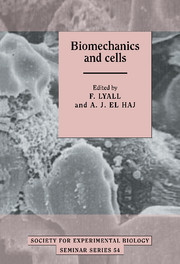Book contents
- Frontmatter
- Contents
- List of contributors
- PART 1 SOFT TISSUE
- Signal transduction pathways in vascular cells exposed to cyclic strain
- Effects of pressure overload on vascular smooth muscle cells
- Effect of increased flow on release of vasoactive substances from vascular endothelial cells
- Modulation of endothelium-derived relaxing factor activity by flow
- Stretch, overload and gene expression in muscle
- Stretch sensitivity in stretch receptor neurones
- Mechanical interactions with plant cells: a selective overview
- Mechanical tensing of cells and chromosome arrangement
- Alterations in gene expression induced by low-frequency, low-intensity electromagnetic fields
- PART 2 HARD TISSUE
- Index
Stretch sensitivity in stretch receptor neurones
Published online by Cambridge University Press: 19 January 2010
- Frontmatter
- Contents
- List of contributors
- PART 1 SOFT TISSUE
- Signal transduction pathways in vascular cells exposed to cyclic strain
- Effects of pressure overload on vascular smooth muscle cells
- Effect of increased flow on release of vasoactive substances from vascular endothelial cells
- Modulation of endothelium-derived relaxing factor activity by flow
- Stretch, overload and gene expression in muscle
- Stretch sensitivity in stretch receptor neurones
- Mechanical interactions with plant cells: a selective overview
- Mechanical tensing of cells and chromosome arrangement
- Alterations in gene expression induced by low-frequency, low-intensity electromagnetic fields
- PART 2 HARD TISSUE
- Index
Summary
Introduction
The sensory terminals of stretch receptor neurones are designed to transduce the energy of a mechanical stimulus into an electrical signal. The molecular mechanisms by which these primary sensory cells sense physical forces are not known. It is generally assumed that depolarisation of the sensory terminals is the result of the activation of ion channels that are gated by mechanical stimuli. But direct characterisation of mechano-sensitive channels in these specialised sensory cells using patch clamp techniques has been limited because of the inaccessibility of the sensory terminals. Stretch-activated channels have been studied in a number of other cell types that are not specialised mechanosensory cells, but whether such channels are good models for mechanosensitive channels of mechanoreceptors is not clear. Stretch receptor neurones in the medicinal leech are particularly useful for studies of mechanosensory transduction because they have large unbranched sensory terminals adjacent to accessible cell bodies.
Electrophysiological studies of vertebrate spindles and crustacean stretch receptors
In the 1950s Katz showed, by recording with extracellular electrodes close to the sensory ending in frog muscle spindles during stretch, that the first detectable step in the transduction process was a local depolarisation of the sensory terminals, termed the receptor potential. Katz used isolated frog muscle spindles that contain between three and 12 intrafusal muscle fibres innervated by a single sensory axon that branches repeatedly and coils around the intrafusal fibres (Katz, 1950).
- Type
- Chapter
- Information
- Biomechanics and Cells , pp. 96 - 106Publisher: Cambridge University PressPrint publication year: 1994

